Introduction- The rich cultural heritage of India is often epitomized by its numerous temples, each with its unique history and intriguing legends. One such temple with immense historical significance and attracts countless visitors is the Talakadu Temple in Mysore, Karnataka. Perched along the tranquil banks of the Cauvery River, this temple complex contains a captivating history that will amaze and motivate all who visit. This article will explore seven intriguing facts about the Talakadu Temple, shedding light on its awe-inspiring architecture, spiritual significance, and the mystical legends surrounding it.
7 Fascinating Facts About Talakadu Temple
1. A Hidden Gem of Ancient Architecture- The Talakadu Temple complex is a treasure trove of architectural marvels that reflect the craftsmanship and ingenuity of ancient India. Comprising five temples dedicated to Lord Shiva, this complex is a testament to the architectural brilliance of the Vijayanagara Empire. The temples are built in the Dravidian style of architecture, characterized by intricately carved pillars, towering gopurams (entrance towers), and exquisite sculptures. As you traverse the intricate structure, you will be amazed at the focus on detail and the harmonious unification of spirituality and creativity in every corner.
2. The Mysterious Buried City-One of the fascinating aspects of Talakadu is the presence of a buried city beneath its sandy dunes. It is commonly accepted that centuries ago, a curse was placed on the city because this cursed city was buried beneath the sand. This mysterious phenomenon has puzzled archaeologists and historians for years. According to the locals, every 12 years, the curse is believed to assert its power, engulfing the entire area in sand. This intriguing legend adds an aura of mystique to the temple complex and makes it a captivating destination for history enthusiasts and curious travellers.
3. The Mythical Curse of Talakadu-Talakadu is steeped in mythology, with an ancient curse being one of its most enduring legends. According to folklore, a queen named Alamelamma cursed the region after the King of Mysore demanded her valuable jewels. The curse stated that the entire city of Talakadu would be engulfed in sand, turning it into a barren desert. The curse is said to have come true, as the city witnessed a massive dune formation that buried its grandeur. The myth adds an intriguing layer to the historical significance of the temple complex, making it a place of wonder and fascination.
4. Panchalinga Darshana – A Rare Spiritual Experience- Talakadu is renowned for its unique spiritual tradition called Panchalinga Darshana. This sacred ritual occurs once every 12 years when the sand covering the temples is removed, revealing the five Shiva lingams (representations of Lord Shiva) in a single line. Devotees from far and wide gather to witness this auspicious event, believed to bestow immense blessings and spiritual fulfilment. The atmosphere during Panchalinga Darshana is truly electric, as the air resonates with devotional chants and the fragrance of incense, creating an otherworldly ambience that is impossible to forget.
5. The Temples and Their Deities- The Talakadu Temple complex is dedicated to Lord Shiva, each housing a different manifestation of the deity. The five temples are named Vaidyeshwara, Maruleshwara, Arakeshw
Ara, Mallikarjuna, and Pathaleshwara. Each temple has its unique architectural features and sacred rituals associated with it. The Vaidyeshwara Temple is believed to have the power to cure diseases, while the Pathaleshwara Temple is considered the gateway to the netherworld. Exploring these temples allows spiritual introspection and unveils the region’s historical and cultural tapestry.
6. The Sacred Cauvery River-The Talakadu Temple complex holds a special significance due to its proximity to the sacred Cauvery River. The river is highly esteemed in Hindu mythology and is considered the home of numerous gods. Devotees often take a holy dip in the river before visiting the temples, believed to cleanse the soul and purify the mind. The serene and picturesque landscape surrounding the river adds to the overall charm of Talakadu, creating a tranquil and meditative atmosphere for visitors.
7. The Festivals and Celebrations-Talakadu come alive during various festivals and celebrations throughout the year, offering visitors a glimpse into the vibrant cultural traditions of the region. One such festival is the Panchalinga Darshana, which attracts a massive influx of devotees. The Maha Shivaratri festival is another grand celebration when the temples are adorned with elaborate decorations and special prayers are offered to Lord Shiva. The festivities during these occasions are a sight to behold, with processions, music, dance performances, and a vibrant display of devotion that fills the air with infectious energy.
Talakadu Temple pooja rituals and timings
Pooja rituals at the Talakadu Temple are performed with great devotion and adhere to the traditional customs and practices of the region. The temple follows a specific schedule for various rituals and timings, which are as follows:
- Morning Pooja: The temple gates open early, usually around 6:00 AM. Devotees can witness the morning pooja, known as “Pratahkal Pooja.” The main deity, Lord Shiva, is offered special prayers, including the Abhishekam (ritual bath) with water, milk, honey, and other sacred substances during this time. The sound of conch shells and bells fills the air, creating a serene and holy atmosphere.
- Noon Pooja: The next significant pooja is conducted around noon, known as the “Madhyahna Pooja.” This ritual involves offering special prayers, performing aarthi (waving of lamps), and chanting hymns to praise Lord Shiva. Devotees often participate in this pooja to seek the blessings of the deity.
- Evening Pooja: As the sun sets, the temple conducts the “Sandhya Aarti.” This pooja marks the transition from day to night and includes lighting lamps, singing devotional songs, and offering flowers and incense to Lord Shiva. The spiritual atmosphere during this time imbues devotees with a sense of serenity and calm.
- Night Pooja: The final pooja of the day is known as the “Ratri Pooja” and takes place before the closing of the temple. Devotees gather to witness this auspicious ritual, which includes dreams (oil lamps) and camphor aarthi, concluding the day’s worship activities.
Apart from these regular poojas, the Talakadu Temple also holds special rituals and festivals on important occasions, such as Maha Shivaratri, Navaratri, and Karthika Deepam. During these festive times, the temple witnesses a significant influx of devotees, who come to offer prayers and seek the blessings of Lord Shiva.
It is important to note that the exact timings of pooja rituals at the Talakadu Temple may vary based on the prevailing customs and traditions. Therefore, it is advised that worshippers consult with the temple authorities or check the website for the most current information.
Visiting the Talakadu Temple and witnessing the pooja rituals provides a spiritual experience connecting devotees with their faith and offering them peace and devotion. The temple’s serene surroundings and the divine energy that permeates the air make it a truly special place for worship and devotion in Karnataka.
Talakadu Temple Picture

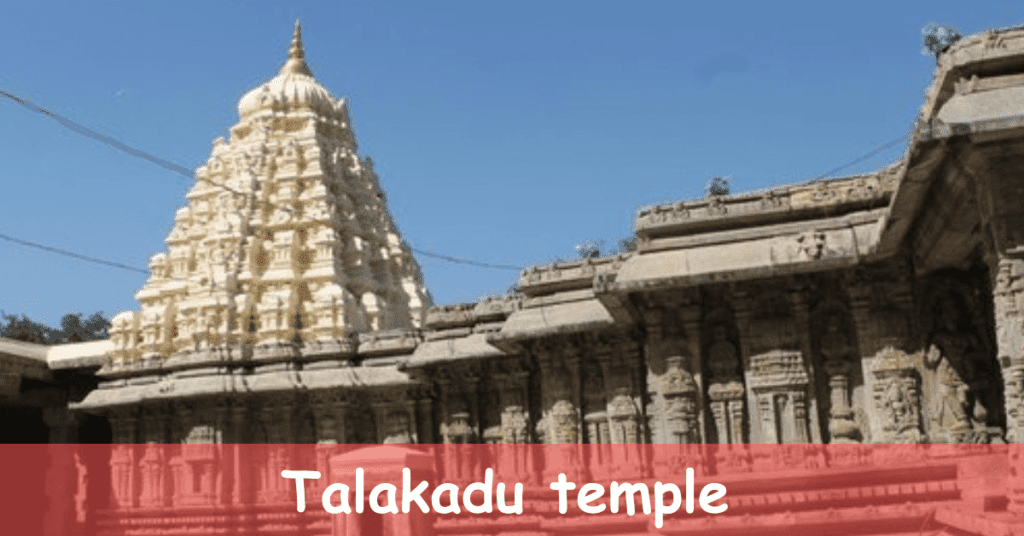
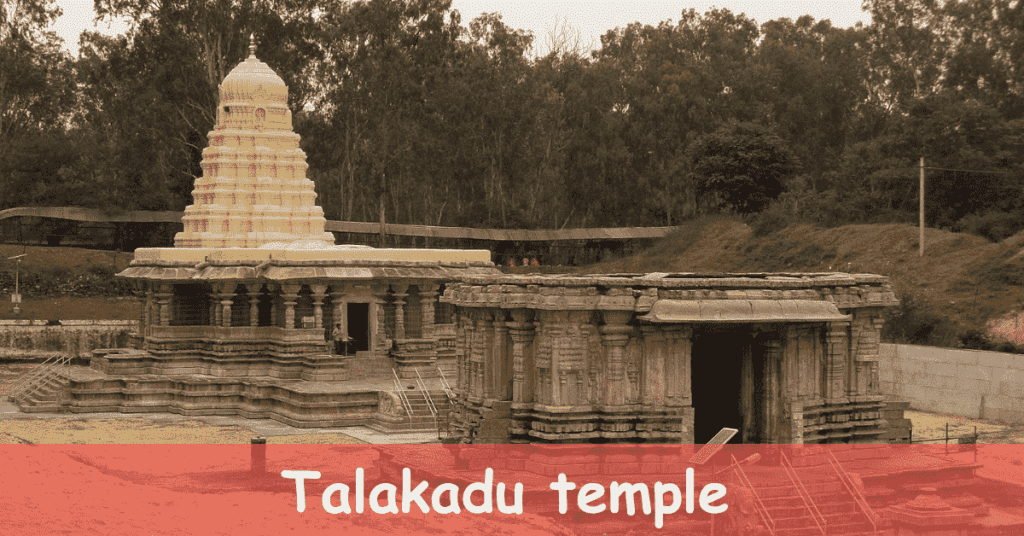
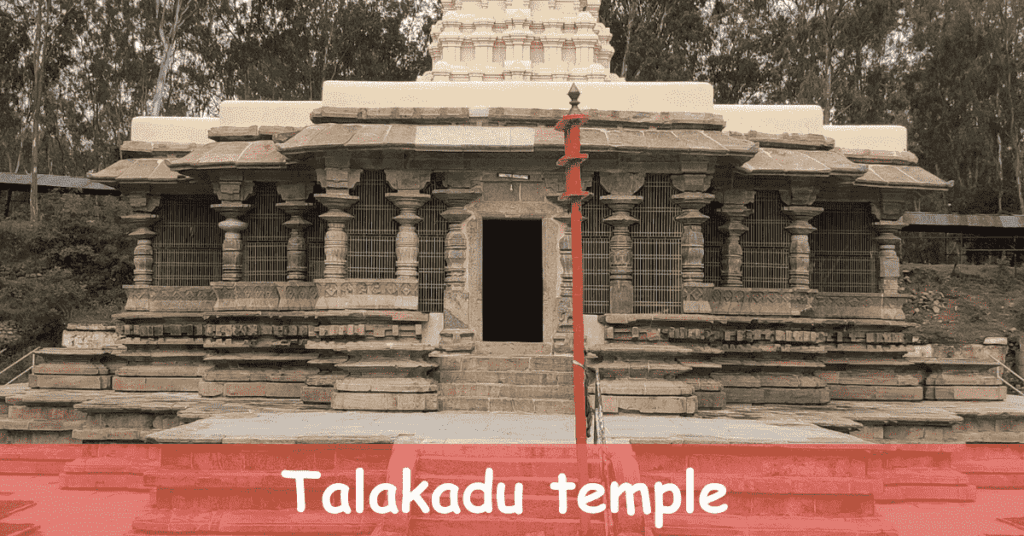

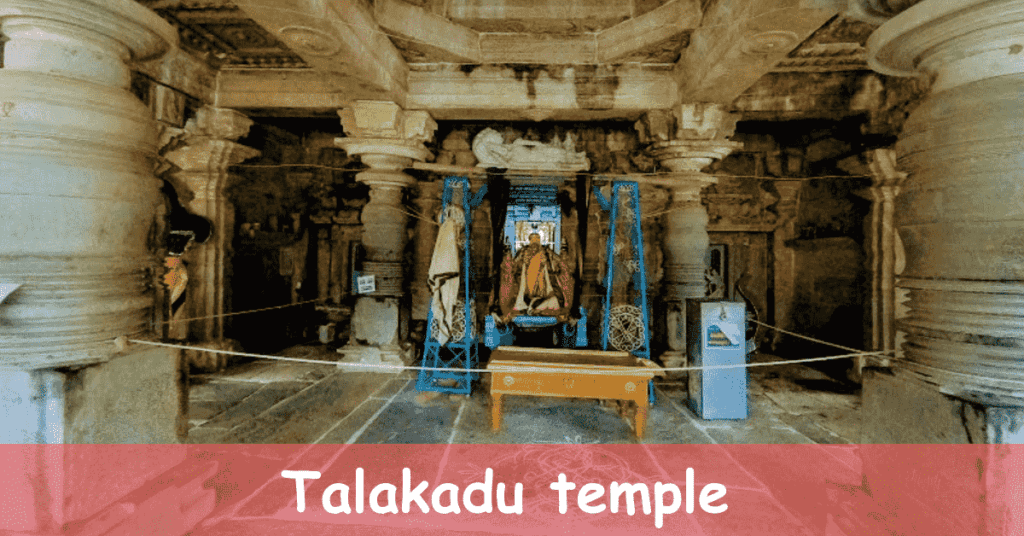

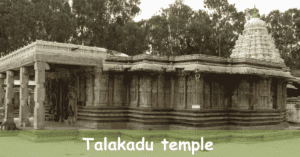
Conclusion
The Talakadu Temple in Mysore, Karnataka offers tourists a special chance to delve into its abundant heritage and culture; it is not merely a spiritual destination. It delivers a fulfilling and enduring experience for everyone who visits. From its awe-inspiring architecture and the intriguing legends surrounding it to the spiritual rituals and vibrant festivals, this temple complex is a testament to the rich heritage of India. Whether seeking solace in spirituality or exploring the depths of ancient history, visiting Talakadu Temple will leave an indelible mark on your soul. Immerse yourself in the magical atmosphere of Talakadu and embark on an unforgettable journey of discovery.
